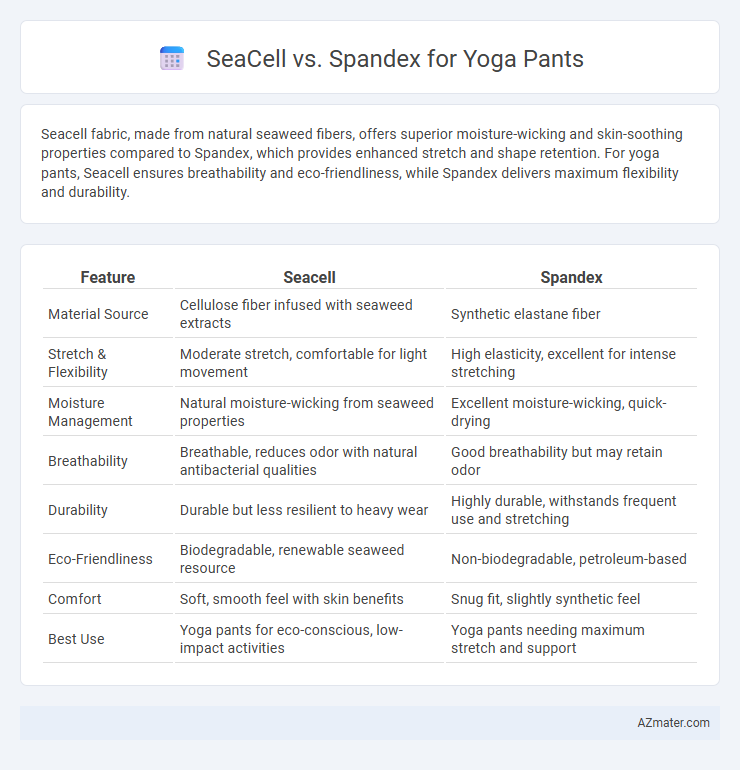Seacell fabric, made from natural seaweed fibers, offers superior moisture-wicking and skin-soothing properties compared to Spandex, which provides enhanced stretch and shape retention. For yoga pants, Seacell ensures breathability and eco-friendliness, while Spandex delivers maximum flexibility and durability.
Table of Comparison
| Feature | Seacell | Spandex |
|---|---|---|
| Material Source | Cellulose fiber infused with seaweed extracts | Synthetic elastane fiber |
| Stretch & Flexibility | Moderate stretch, comfortable for light movement | High elasticity, excellent for intense stretching |
| Moisture Management | Natural moisture-wicking from seaweed properties | Excellent moisture-wicking, quick-drying |
| Breathability | Breathable, reduces odor with natural antibacterial qualities | Good breathability but may retain odor |
| Durability | Durable but less resilient to heavy wear | Highly durable, withstands frequent use and stretching |
| Eco-Friendliness | Biodegradable, renewable seaweed resource | Non-biodegradable, petroleum-based |
| Comfort | Soft, smooth feel with skin benefits | Snug fit, slightly synthetic feel |
| Best Use | Yoga pants for eco-conscious, low-impact activities | Yoga pants needing maximum stretch and support |
Introduction to Seacell and Spandex Fabrics
Seacell fabric, made from natural seaweed fibers combined with cellulose, offers breathability, moisture-wicking, and skin-nourishing properties, making it ideal for sustainable yoga wear. Spandex, a synthetic fiber known for its superior elasticity and shape retention, provides excellent stretch and flexibility, enhancing comfort during yoga practice. Comparing Seacell and Spandex highlights the contrast between eco-friendly, skin-beneficial materials and high-performance stretch fabrics commonly used in yoga pants.
Origins and Production Processes
Seacell is a fiber derived from renewable seaweed combined with cellulose, harvested from sustainable algae farms through eco-friendly extraction methods, while Spandex is a synthetic fiber made from polyurethane polymers produced via a chemical reaction called the prepolymer process. Seacell's production emphasizes natural, biodegradable components with minimal environmental impact, whereas Spandex manufacturing involves energy-intensive polymerization and solvent use typical of petrochemical industries. These foundational differences influence the sustainability and breathability characteristics of yoga pants made from each material.
Comfort and Wearability Comparison
Seacell yoga pants offer superior moisture-wicking and breathability due to their seaweed-infused fibers, enhancing comfort during intense workouts. Spandex provides exceptional stretch and shape retention, ensuring flexibility and a snug fit ideal for dynamic movements. While Seacell excels in skin-friendly softness and natural odor control, Spandex outperforms in durability and elasticity, making the choice dependent on specific comfort and wearability needs.
Moisture-Wicking and Breathability
Seacell fabric offers superior moisture-wicking properties by incorporating seaweed fibers that naturally regulate humidity, keeping the skin dry during intense yoga sessions. Spandex, known for its exceptional stretch and shape retention, provides moderate breathability but typically less efficient moisture absorption compared to Seacell. For yoga pants emphasizing moisture management and breathability, Seacell blends deliver enhanced comfort and natural airflow, whereas Spandex is primarily valued for flexibility and fit.
Stretch and Flexibility Performance
Seacell fabric, infused with seaweed fibers, offers moderate stretch and excellent moisture-wicking properties, making it comfortable for low to medium-intensity yoga sessions. Spandex, known for its exceptional elasticity, provides superior stretch and recovery, ensuring maximum flexibility and unrestricted movement during intense yoga poses. Combining Seacell with Spandex results in yoga pants that balance natural breathability with high-performance stretch and flexibility.
Skin Sensitivity and Hypoallergenic Properties
Seacell fabric, infused with seaweed fibers, offers natural skin-soothing benefits and is rich in antioxidants, making it ideal for sensitive skin during yoga practice. Spandex provides superior stretch and comfort but can sometimes cause irritation for those with skin allergies due to its synthetic nature. For hypoallergenic properties, Seacell is preferable as it reduces skin irritation and promotes breathability, while Spandex prioritizes flexibility over skin sensitivity.
Sustainability and Environmental Impact
Seacell fabric, derived from seaweed cellulose, offers a sustainable alternative to spandex by being biodegradable and requiring minimal water and chemical use during production. In contrast, spandex is petroleum-based, non-biodegradable, and contributes to microplastic pollution when washed, raising significant environmental concerns. Choosing Seacell yoga pants supports eco-friendly materials and reduces carbon footprint compared to conventional synthetic fibers like spandex.
Durability and Longevity in Yoga Practice
Seacell fabric incorporates natural fibers infused with seaweed extracts, offering moderate durability ideal for light to moderate yoga sessions, but it may show wear faster under rigorous daily practice. Spandex, known for its exceptional elasticity and resistance to stretching and tearing, provides superior durability and retains shape through extensive movement, making it highly suitable for intensive yoga routines. Choosing spandex-infused yoga pants ensures longer-lasting performance and sustained fit, while Seacell prioritizes comfort and skin benefits over maximum longevity.
Cost and Price Differences
Seacell yoga pants typically cost more than spandex options due to the inclusion of natural seaweed fibers combined with sustainable production methods, providing added skin benefits and eco-friendliness. Spandex yoga pants are more budget-friendly, offering high elasticity and durability at a lower price point, making them accessible for a wider consumer base. The price difference generally reflects the value consumers place on Seacell's unique fabric technology versus the affordability and stretch efficiency of traditional spandex.
Best Choice: Seacell vs Spandex for Yoga Pants
Seacell delivers superior breathability, moisture-wicking, and eco-friendly benefits, making it an excellent choice for yoga pants focused on comfort and sustainability. Spandex offers unmatched stretch and recovery, providing maximum flexibility and shape retention during intense yoga sessions. For those prioritizing natural fibers and skin-friendly properties, Seacell stands out, while Spandex remains the top pick for performance-driven stretch and durability.

Infographic: Seacell vs Spandex for Yoga pant
 azmater.com
azmater.com